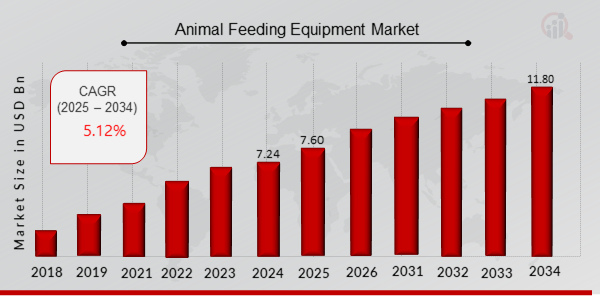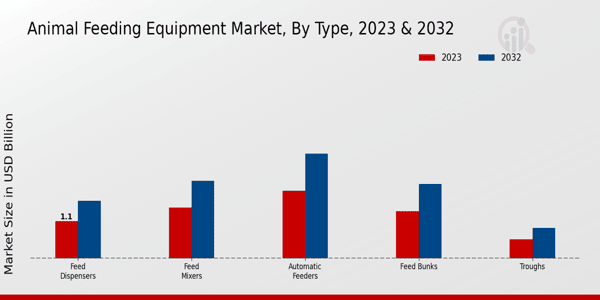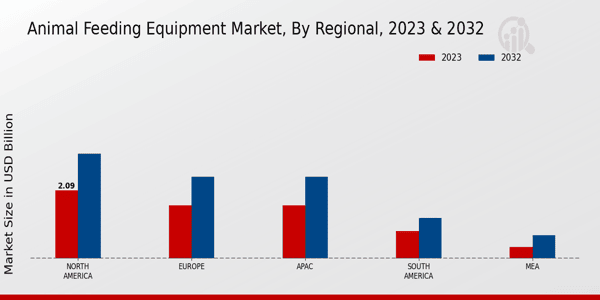Animal Feeding Equipment Market Overview
As per MRFR analysis, the Animal Feeding Equipment Market Size was estimated at 7.24 (USD Billion) in 2024. The Animal Feeding Equipment Market Industry is expected to grow from 7.60 (USD Billion) in 2025 to 11.80 (USD Billion) till 2034, at a CAGR (growth rate) is expected to be around 5.01% during the forecast period (2025 - 2034).
Key Animal Feeding Equipment Market Trends Highlighted
The Animal Feeding Equipment Market is experiencing significant growth driven by several key factors. One of the primary market drivers is the increasing demand for high-quality livestock feed driven by the rising global population and the corresponding need for protein-rich food sources. This demand necessitates better feeding solutions that enhance efficiency and improve animal health. Moreover, advancements in technology are enabling more automated and precise feeding systems, leading to better productivity and reduced waste. As farmers and producers seek to optimize their operations, innovative feeding equipment has become essential for meeting modern agricultural challenges.
There are numerous opportunities to be explored within this market. Manufacturers can focus on developing smart feeding solutions that integrate IoT technology, providing real-time monitoring and data analysis for better decision-making. Additionally, there is a growing trend towards sustainable and organic farming practices, opening avenues for equipment that supports environmentally friendly feeding methods. As consumers become more conscious of their food sources, the demand for traceability and transparency in animal feeding systems presents further possibilities for innovation and growth. In recent times, there has been a noticeable shift towards the adoption of automated and robotic solutions in animal feeding.
This trend reflects the broader movement towards operational efficiency and labor reduction in agriculture. Producers are increasingly recognizing the benefits of precision feeding, which can lead to improved feed conversion ratios and healthier livestock. Moreover, the growing emphasis on animal welfare and nutrition is shaping the landscape, encouraging the development of equipment that promotes better feeding practices while ensuring the well-being of animals. The combined influence of these trends is reshaping the way animal feeding equipment is perceived and utilized, making it a crucial element of future agricultural practices. As the landscape evolves, stakeholders must stay attuned to these shifts to fully leverage the potential of the market.

Source: Primary Research, Secondary Research, MRFR Database and Analyst Review
Animal Feeding Equipment Market Drivers
Growing Demand for Livestock Products
The Animal Feeding Equipment Market Industry is expanding significantly as there is an increasing demand for livestock produce like meat, milk and eggs. According to current trends, as the world population continues to increase, so does the demand for animal products, leading farmers and producers to source better feeding gear suitable for their production. The transition from traditional to modern farming practices has led to an upsurge in the adoption of advanced feeding technologies, which not only improve the feed conversion ratios but also enhance the overall health and productivity of livestock.
Increased awareness regarding the nutritional value and safety of animal products has further driven the market, leading to a need for innovative feeding solutions that can cater to the diverse dietary requirements of different animal species. Additionally, with the emphasis on sustainable agricultural practices, farmers are increasingly investing in precision feeding equipment that minimizes waste and maximizes feed efficiency, positioning the Animal Feeding Equipment Market Industry for robust growth in the coming years.
Technological Advancements in Feeding Equipment
Technological innovations play a crucial role in the growth of the Animal Feeding Equipment Market Industry. Modern feeding equipment now incorporates advanced features such as automation, smart technology and real-time monitoring systems. These advancements not only enhance feeding accuracy but also streamline operational efficiency for farmers. The introduction of automated feeding systems allows for consistent nutrition delivery, which is essential for animal health and productivity.
As farmers seek to optimize their operations, the demand for technologically advanced feeding equipment is rapidly increasing, significantly contributing to the market’s expansion. The integration of digital tools and IoT in feeding systems offers data-driven insights into feeding behaviors, ensuring better management and productivity in livestock farming.
Increased Focus on Animal Welfare
The rising awareness and advocacy for animal welfare is another significant driver for the Animal Feeding Equipment Market Industry. Consumers are becoming more conscious of the ethical treatment of animals and are demanding higher standards for livestock farming practices. This shift in consumer sentiment is prompting farmers to invest in feeding equipment that promotes better living conditions and nutritional health for animals. Enhanced feeding solutions are being developed to cater to the specific needs of various animal species, thereby ensuring that they receive adequate nutrition in a stress-free environment.The push for compliance with stringent animal welfare regulations further accelerates the adoption of innovative feeding technologies, positively impacting the growth of the market.
Animal Feeding Equipment Market Segment Insights:
Animal Feeding Equipment Market Type Insights
The Global Animal Feeding Equipment Market, categorized by Type, showcases a robust structure with critical dynamics influencing its growth. As of 2023, the total valuation stands at 6.57 USD Billion, reflecting its significance in the agricultural sector. Within this market, various categories emerge, with Automatic Feeders representing a noteworthy segment valued at 2.0 USD Billion, expected to escalate to 3.1 USD Billion by 2032, underscoring their increasing adoption for efficient food distribution in livestock management. Feed Mixers follow closely, holding a valuation of 1.5 USD Billion in 2023, projected to reach 2.3 USD Billion in 2032, as these devices are pivotal for ensuring dietary consistency for animals, therefore enhancing productivity.
Feed Bunks, another significant category, are poised at 1.4 USD Billion in 2023 and are set to grow to 2.2 USD Billion by 2032, serving as essential structures for holding large quantities of feed for easy access by animals. Feed Dispensers command a noteworthy share in the market, valued at 1.1 USD Billion in 2023 and expected to rise to 1.7 USD Billion by 2032; they are critical for specialized feeding processes, facilitating precise distribution, which is vital for animal health and growth. Troughs, while the smallest segment with a valuation of 0.57 USD Billion in 2023 is projected to grow to 0.9 USD Billion by 2032, demonstrating their importance in streamlining access to feed while ensuring minimal waste.
The Animal Feeding Equipment Market revenue reflects a trend toward enhanced automation and efficiency as producers seek innovative solutions to optimize animal nourishment and manage feed resources better. Growth drivers in this segment include the rising demand for more efficient feeding systems, which contribute to the health and productivity of livestock. Challenges in this sector may arise from the initial investment costs and the need for technological integration, yet these are countered by the substantial opportunities presented by advancements in feeding technology and automation. Overall, the insights into this Type segment reveal a continually evolving landscape that caters to the increasing complexity of feeding systems, reinforcing the critical role these technologies play in modern agriculture.

Source: Primary Research, Secondary Research, MRFR Database and Analyst Review
Animal Feeding Equipment Market Animal Type Insights
The segmentation within this market includes Cattle, Poultry Feed, Swine, Aquaculture and Equine, each reflecting the specific feeding equipment needs essential for their optimal health and productivity. Poultry feeding equipment, for example, plays a crucial role in supporting the rapid growth of this sector, driven by increasing consumer demand for poultry products globally. Similarly, the Cattle segment is significant due to rising beef consumption, stimulating innovations in feeding solutions to enhance livestock nutrition.The Swine category witnesses growth as pork remains a major protein source in various regions, emphasizing the need for specialized feeding systems.
Furthermore, Aquaculture is on the rise due to the increasing popularity of fish as a protein alternative, and efficient feeding methods in this segment are essential for sustainability. The Equine market, albeit smaller, is important due to the growing interest in recreational horse riding and competitions, which drives demand for quality feeding equipment. Overall, the Animal Feeding Equipment Market revenue is expected to grow significantly, reflecting evolving industry demands and consumer choices.
Animal Feeding Equipment Market Feeding System Insights
This segment is crucial as it addresses the various methods of providing feed to livestock, ensuring efficient nutrition management and enhancing productivity. Within the Feeding System segment, different methods are employed, including Manual Feeding, which requires human intervention and is often favored in small-scale operations due to its low initial costs. Semi-Automated Feeding represents a blend of human and machine involvement, providing flexibility to farmers and a balance between efficiency and control.
Meanwhile, Automated Feeding systems are gaining traction due to their ability to optimize feed distribution, reduce labor costs, and minimize waste, making them particularly significant in larger-scale farming operations. The increase in livestock farming and the growing trend towards automation in agriculture are key drivers for the market's growth. While there are challenges, such as high initial costs for automated systems, the ongoing advancements in technology present opportunities for innovation and improved feeding practices. Overall, the Animal Feeding Equipment Market revenue continues to grow, with various methodologies catering to the specific needs of farmers and driving market dynamics on a global scale.
Animal Feeding Equipment Market End User Insights
Farmers play a crucial role in utilizing these feeding systems to improve livestock management and enhance productivity, which significantly drives market growth. Feed Manufacturers are key players as they rely heavily on efficient feeding equipment for large-scale production and product consistency, contributing substantially to the overall demand.
Aquaculture Producers benefit from specialized feeding systems designed for aquatic species, which optimize feeding practices and promote sustainable growth. Research Institutions leverage advanced feeding technologies for studies aimed at improving animal nutrition and welfare, ensuring innovation in the industry. The continued evolution and sophistication of feeding equipment across these segments reflect broader market trends driven by the need for greater efficiency, sustainability, and animal health, presenting significant opportunities while also facing challenges like cost management and regulatory compliance.The Animal Feeding Equipment Market data indicates robust growth potential across these various user segments as the industry adapts to emerging trends.
Animal Feeding Equipment Market Regional Insights
The Regional segmentation of the Animal Feeding Equipment Market showcases significant valuations, with North America leading the market at 2.09 USD Billion in 2023 and projected to reach 3.22 USD Billion by 2032, highlighting its majority holding in the industry due to advanced agricultural practices and high demand for automated feeding solutions. Europe follows closely with a valuation of 1.64 USD Billion in 2023, expected to grow to 2.51 USD Billion, as the region embraces innovative feeding technologies to enhance livestock productivity.
The APAC region, sharing the same current valuation as Europe at 1.64 USD Billion, shows a notable growth trend driven by increasing meat consumption and expanding livestock management practices, positioning it as a significant player in the market. Meanwhile, South America and MEA demonstrate smaller but important market presences, valued at 0.84 USD Billion and 0.36 USD Billion, respectively, in 2023. The growth in these regions aligns with evolving agricultural practices and the rising need for efficient feeding systems, reflecting opportunities within the Animal Feeding Equipment Market industry.However, challenges such as fluctuating feed prices and regulatory constraints may impact overall market growth.

Source: Primary Research, Secondary Research, MRFR Database and Analyst Review
Animal Feeding Equipment Market Key Players and Competitive Insights:
The Animal Feeding Equipment Market is characterized by a dynamic landscape where various players utilize innovative technologies and strategic approaches to capture market share. As the demand for efficient and sustainable farming practices rises, these companies are focusing on developing advanced equipment that ensures optimal feeding solutions for different types of livestock. Key drivers behind this market's growth include the increasing awareness of the benefits of automated feeding systems, the growing livestock population, and the rising need for cost-effective solutions that enhance productivity and animal welfare. Competitive insights reveal a landscape where not only product quality but also customer service, technological innovation, and adaptability to changing market needs play crucial roles in determining the success of businesses in this sector.
Ziggity Systems stands out in the Animal Feeding Equipment Market with a robust reputation for providing reliable and innovative feeding solutions tailored for livestock. The company's strengths lie in its commitment to research and development, which allows it to introduce state-of-the-art technologies that enhance the efficiency of feeding systems. Ziggity Systems focuses on delivering products that improve not just productivity but also the health and well-being of animals, which resonates well with modern farming practices that prioritize animal welfare. Furthermore, Ziggity Systems has established a strong global presence, enabling it to cater to a diverse customer base across different regions, adapting to the unique needs of various agricultural environments. The company’s consistent emphasis on customer feedback and satisfaction ensures that it remains at the forefront of the competitive landscape.
Hansen AgriPLACEMENT complements the Animal Feeding Equipment Market with its extensive experience in the agricultural sector, emphasizing quality service and expertise in livestock management. The company has carved out a niche by offering tailored solutions that meet the specific requirements of its clients. Hansen AgriPLACEMENT focuses on relationships built on trust and responsiveness, ensuring it understands the nuances of its customers' needs. Its strength lies in its dedicated workforce and their in-depth knowledge of animal feeding systems, which allows for effective training and support for clients integrating new equipment into their operations. The company’s commitment to the agricultural community and its focus on building long-lasting partnerships position it as a significant player within the animal feeding equipment landscape, helping farms optimize feeding practices through practical and comprehensive solutions.
Key Companies in the Animal Feeding Equipment Market Include:
- Ziggity Systems
- Hansen AgriPLACEMENT
- DeLaval
- AGCO Corporation
- Trouw Nutrition
- Syncra Systems
- Cargill
- Lemken
- Big Dutchman
- GEA Group
- Petersime
- Chapman Taylor LLP
- Buhler Industries
- Patz Corporation
- Alltech
Animal Feeding Equipment Market Industry Developments
In recent developments within the Global Animal Feeding Equipment Market, companies like Ziggity Systems and DeLaval have been focusing on innovation to enhance feeding efficiency and animal welfare. AGCO Corporation has invested in technology to interpret data analytics for optimizing animal nutrition, reflecting a growing trend toward data-driven solutions. Trouw Nutrition is expanding its market presence through strategic partnerships aimed at improving feed quality. There have also been significant movements among key players in terms of mergers and acquisitions.
For instance, Cargill has been acquiring niche firms to broaden its product offerings in animal nutrition, while Big Dutchman has been actively merging with smaller tech firms to fortify its technological capabilities in automated feeding systems. Growth valuation has surged recently, with companies like GEA Group and Alltech witnessing increased market valuations, driven by rising demand for efficient animal husbandry practices and sustainable feeding solutions. The evolving requirements for improved production efficiency are further fueling advancements across the sector, impacting the competitive landscape and prompting firms to adapt quickly to consumer needs.
Animal Feeding Equipment Market Segmentation Insights
Animal Feeding Equipment Market Type Outlook
- Feed Dispensers
- Feed Mixers
- Automatic Feeders
- Feed Bunks
- Troughs
Animal Feeding Equipment Market Animal Type Outlook
- Cattle
- Poultry
- Swine
- Aquaculture
- Equine
Animal Feeding Equipment Market Feeding System Outlook
- Manual Feeding
- Semi-Automated Feeding
- Automated Feeding
Animal Feeding Equipment Market End User Outlook
- Farmers
- Feed Manufacturers
- Aquaculture Producers
- Research Institutions
Animal Feeding Equipment Market Regional Outlook
- North America
- Europe
- South America
- Asia Pacific
- Middle East and Africa
| Report Attribute/Metric |
Details |
|
Market Size 2024
|
7.24 (USD Billion)
|
|
Market Size 2025
|
7.60 (USD Billion)
|
|
Market Size 2034
|
11.80 (USD Billion)
|
|
Compound Annual Growth Rate (CAGR)
|
5.01 % (2025 - 2034)
|
|
Report Coverage
|
Revenue Forecast, Competitive Landscape, Growth Factors, and Trends
|
|
Base Year
|
2024
|
|
Market Forecast Period
|
2025 - 2034
|
|
Historical Data
|
2020 - 2024
|
| Market Forecast Units |
USD Billion |
| Key Companies Profiled |
Ziggity Systems, Hansen AgriPLACEMENT, DeLaval, AGCO Corporation, Trouw Nutrition, Syncra Systems, Cargill, Lemken, Big Dutchman, GEA Group, Petersime, Chapman Taylor LLP, Buhler Industries, Patz Corporation, Alltech |
| Segments Covered |
Type, Animal Type, Feeding System, End User, Regional |
| Key Market Opportunities |
1. Technological advancements in automation, 2. Growing demand for organic livestock, 3. Expansion in developing regions, 4. Increased focus on animal health, 5. E-commerce platforms for equipment sales |
| Key Market Dynamics |
1. Technological advancements in equipment, 2. Growing demand for livestock productivity, 3. Increasing focus on animal health, 4. Rising adoption of automation, 5. Expanding feed production capabilities |
| Countries Covered |
North America, Europe, APAC, South America, MEA |
Frequently Asked Questions (FAQ) :
The Animal Feeding Equipment Market is expected to be valued at 11.80 USD Billion by 2034.
The expected CAGR for the Animal Feeding Equipment Market from 2025 to 2034 is 5.01%.
North America is projected to have the largest market share in the Global Animal Feeding Equipment Market, valued at 3.22 USD Billion by 2032.
The market value of Automatic Feeders in the Animal Feeding Equipment Market is expected to reach 3.1 USD Billion by 2032.
By 2032, the market size for Feed Mixers is anticipated to reach 2.3 USD Billion.
Key players in the Animal Feeding Equipment Market include Ziggity Systems, AGCO Corporation, and Cargill, among others.
The Animal Feeding Equipment Market is divided into regions such as North America, Europe, APAC, South America, and MEA.
Feed Bunks in the Animal Feeding Equipment Market are expected to be valued at 2.2 USD Billion by 2032.
By 2032, the projected market value for Troughs is expected to reach 0.9 USD Billion.
The Asia-Pacific region is expected to witness significant growth, with an expected market value of 2.51 USD Billion by 2032.


















